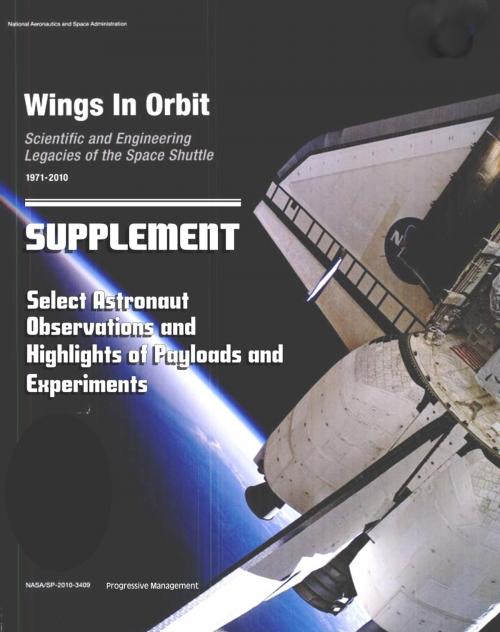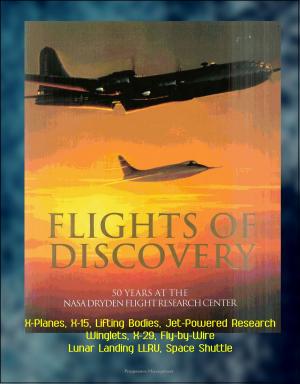Wings in Orbit: Scientific and Engineering Legacies of the Space Shuttle - Select Astronaut Observations and Highlights of Shuttle Program Payloads and Experiments Supplement (NASA TM-2011-216150)
Nonfiction, Science & Nature, Technology, Aeronautics & Astronautics, Science, Physics, Astrophysics & Space Science| Author: | Progressive Management | ISBN: | 9781476265254 |
| Publisher: | Progressive Management | Publication: | May 17, 2012 |
| Imprint: | Smashwords Edition | Language: | English |
| Author: | Progressive Management |
| ISBN: | 9781476265254 |
| Publisher: | Progressive Management |
| Publication: | May 17, 2012 |
| Imprint: | Smashwords Edition |
| Language: | English |
This NASA technical memorandum is an invaluable supplement to the acclaimed Shuttle history, Wings in Orbit, compiled to provide selected highlights of the science and engineering payloads, experiments, engineering and scientific tests, and other technical activities that were carried out during the Space Shuttle era. It is very important to note that this TM highlights selected payloads and experiments to offer glimpses into the intensive scientific and engineering initiatives throughout the Space Shuttle Program. Described as quite detailed and highly informative, it is designed to give readers an overview of the shuttle science and engineering payloads.
Contents: Select Astronaut Observations * William Anders * Robert Cabana * Leroy Chiao * Eileen Collins * Gregory Harbaugh * Tom Jones * Richard Searfoss * Dafydd Williams * Payloads and Experiments * U.S. Department of Defense * International/Construction of International Space Station * Education * Earth Science * Space Science * Microgravity * Space Biology * Astronaut Health and Performance * Commercial * Engineering
From the introduction:
We have included selected personal observations provided by a handful of astronauts who responded to our call for submitting personal experiences by the shuttle flight crew. We gratefully acknowledge their contributions to this publication. These essays provide insights into the shuttle operations as experienced by those who flew this magnificent machine.
The shuttle has been a crown jewel in NASA's human spaceflight program for over 3 decades. This spectacular flying machine served as a symbol of our nation's prowess in science and technology as well as a demonstration of our nation's "can-do" attitude. The Space Shuttle Program was a major leap forward in our quest for space exploration. So, what made Space Shuttle unique? The shuttle launched as a rocket, served as an orbital workstation and space habitat, and landed like a glider. The American engineering that conceived of, designed, and manufactured the shuttle was innovative for its time, providing capabilities beyond our expectations in all disciplines related to the process of launching, working in space, and returning to Earth. We learned with every succeeding flight how to operate more efficiently and effectively in space. This knowledge will translate to all future space vehicles and the ability of their crews to live and work in space.
The Space Shuttle served as a workhorse for space operations and scientific research. Satellite launching, repair, and retrieval provided the satellite industry with important capabilities. The Department of Defense, national security organizations, and commercial companies used the shuttle to support their unique missions. Without the shuttle and its servicing mission crews, the magnificent Hubble Space Telescope astronomical science discoveries would not have been possible. Laboratories carried in the payload bay of the shuttles provided opportunities to use microgravity's attributes for understanding human health, physical and material sciences, and biology. Shuttle research advanced our understanding of planet Earth, our own star—the sun—as well as our atmosphere and oceans. From orbit aboard the shuttle, astronaut crews collected hundreds of thousands of Earth observation images and used innovative radar sensors to map 90% of its land surface.
This NASA technical memorandum is an invaluable supplement to the acclaimed Shuttle history, Wings in Orbit, compiled to provide selected highlights of the science and engineering payloads, experiments, engineering and scientific tests, and other technical activities that were carried out during the Space Shuttle era. It is very important to note that this TM highlights selected payloads and experiments to offer glimpses into the intensive scientific and engineering initiatives throughout the Space Shuttle Program. Described as quite detailed and highly informative, it is designed to give readers an overview of the shuttle science and engineering payloads.
Contents: Select Astronaut Observations * William Anders * Robert Cabana * Leroy Chiao * Eileen Collins * Gregory Harbaugh * Tom Jones * Richard Searfoss * Dafydd Williams * Payloads and Experiments * U.S. Department of Defense * International/Construction of International Space Station * Education * Earth Science * Space Science * Microgravity * Space Biology * Astronaut Health and Performance * Commercial * Engineering
From the introduction:
We have included selected personal observations provided by a handful of astronauts who responded to our call for submitting personal experiences by the shuttle flight crew. We gratefully acknowledge their contributions to this publication. These essays provide insights into the shuttle operations as experienced by those who flew this magnificent machine.
The shuttle has been a crown jewel in NASA's human spaceflight program for over 3 decades. This spectacular flying machine served as a symbol of our nation's prowess in science and technology as well as a demonstration of our nation's "can-do" attitude. The Space Shuttle Program was a major leap forward in our quest for space exploration. So, what made Space Shuttle unique? The shuttle launched as a rocket, served as an orbital workstation and space habitat, and landed like a glider. The American engineering that conceived of, designed, and manufactured the shuttle was innovative for its time, providing capabilities beyond our expectations in all disciplines related to the process of launching, working in space, and returning to Earth. We learned with every succeeding flight how to operate more efficiently and effectively in space. This knowledge will translate to all future space vehicles and the ability of their crews to live and work in space.
The Space Shuttle served as a workhorse for space operations and scientific research. Satellite launching, repair, and retrieval provided the satellite industry with important capabilities. The Department of Defense, national security organizations, and commercial companies used the shuttle to support their unique missions. Without the shuttle and its servicing mission crews, the magnificent Hubble Space Telescope astronomical science discoveries would not have been possible. Laboratories carried in the payload bay of the shuttles provided opportunities to use microgravity's attributes for understanding human health, physical and material sciences, and biology. Shuttle research advanced our understanding of planet Earth, our own star—the sun—as well as our atmosphere and oceans. From orbit aboard the shuttle, astronaut crews collected hundreds of thousands of Earth observation images and used innovative radar sensors to map 90% of its land surface.















